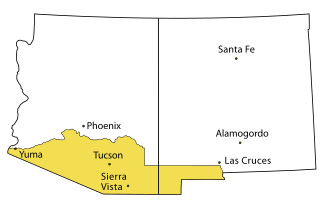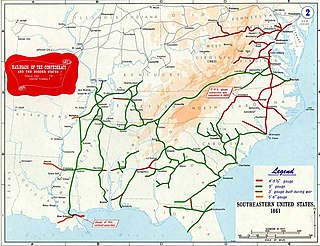
The Gadsden Purchase is a 29,640-square-mile (76,800 km2) region of present-day southern Arizona and southwestern New Mexico that the United States acquired from Mexico by the Treaty of Mesilla, which took effect on June 8, 1854. The purchase included lands south of the Gila River and west of the Rio Grande where the U.S. wanted to build a transcontinental railroad along a deep southern route, which the Southern Pacific Railroad later completed in 1881–1883. The purchase also aimed to resolve other border issues.

John Anthony Quitman was an American lawyer, politician, and soldier. As President of the Mississippi Senate, he served one month as Acting Governor of Mississippi as a Whig. He was elected governor in 1849 as a Democrat, and served from January 10, 1850, until his resignation on February 3, 1851, shortly after his arrest for violating U.S. neutrality laws. He was strongly pro-slavery and a leading Fire-Eater.

The Gulf, Mobile and Ohio was a Class I railroad in the central United States whose primary routes extended from Mobile, Alabama, and New Orleans, Louisiana, to St. Louis and Kansas City, Missouri, as well as Chicago, Illinois.
Wahalak is a small unincorporated community in central Kemper County, Mississippi, United States.

The American Civil War was the first conflict where large armies heavily relied on railroads for transporting supplies. The Confederate States Army's railroad system was fragile and primarily designed for short hauls of cotton to nearby rivers or ocean port. Due to the South's limited manufacturing and industrial capacity, obtaining new parts during the war was challenging. Consequently, the railroad system deteriorated due to overuse, lack of maintenance, and systematic destruction by Union raiders.

The Alton Railroad was the final name of a railroad linking Chicago to Alton, Illinois; St. Louis, Missouri; and Kansas City, Missouri. Its predecessor, the Chicago and Alton Railroad, was purchased by the Baltimore and Ohio Railroad in 1931 and was controlled until 1942 when the Alton was released to the courts. On May 31, 1947, the Alton Railroad was merged into the Gulf, Mobile and Ohio Railroad. Jacob Bunn had been one of the founding reorganizers of the Chicago & Alton Railroad Company during the 1860s.

Mayhew is an unincorporated community in Lowndes County, Mississippi.
McCrary is an unincorporated community in Lowndes County, Mississippi. McCrary is located southeast of Columbus and northeast of New Hope on the Mississippi/Alabama state line.
Penns, also known as Penn or Penns Station, is an unincorporated community in Lowndes County, Mississippi. Penns is located south of Artesia on U.S. Route 45.

Lauderdale is an unincorporated community and census-designated place (CDP) in Lauderdale County, Mississippi, United States. The population of Lauderdale was 395 at the 2020 census. It is located along U.S. Highway 45, 16 miles (26 km) northeast of Meridian.

Captain Robert Townsend was a Civil War-era ship captain in the United States Navy. He served twice, once before the war then again during the war. He saw active combat while serving aboard three ships, most notably as commander of the USS Essex from 1863 to 1864, an ironclad gunship on the Mississippi River. Captain Townsend died of heatstroke while commanding the USS Wachusett in China in 1866, and is buried in Albany, New York.
Middleton is a former town in Montgomery County, Mississippi, United States. Once a thriving commercial and educational center, Middleton was bypassed in 1859 when the Mississippi Central Railway built its line through nearby Winona. Businesses and residents followed the railroad, and Middleton was abandoned. Little remains of the town today but its cemetery, which was restored in 1992 by the Lions Club of Winona.

Walker is an unincorporated community in Herzog Township, Ellis County, Kansas, United States. It is located between Hays and Russell, along old Hwy 40 on the north side of I-70. Walker has a post office with ZIP code 67674.

Walsh is an unincorporated community located in the town of Porterfield, in Marinette County, Wisconsin, United States.
Princeton is a ghost town located in Washington County, Mississippi, United States.
Agency is a ghost town located in Oktibbeha County, Mississippi, United States.
Winchester is a ghost town in Wayne County, Mississippi, United States.
Danville is a ghost town in Alcorn County, Mississippi, United States.
Tuscola is an unincorporated community in Leake County, in the U.S. state of Mississippi.
Eastport is an unincorporated community in Tishomingo County, Mississippi, United States. During the 1840s and 1850s, Eastport became an important river port and boasted a population of 2,000 and many businesses. In 1857, the railroad missed Eastport and the townspeople began moving to nearby Iuka. During the American Civil War, the town again became an important river port, but by the 1890s the post office closed. When the Tennessee River was dammed to create Pickwick Lake in the 1930s, the old town was submerged. Eastport still exists as a small community with a marina.












